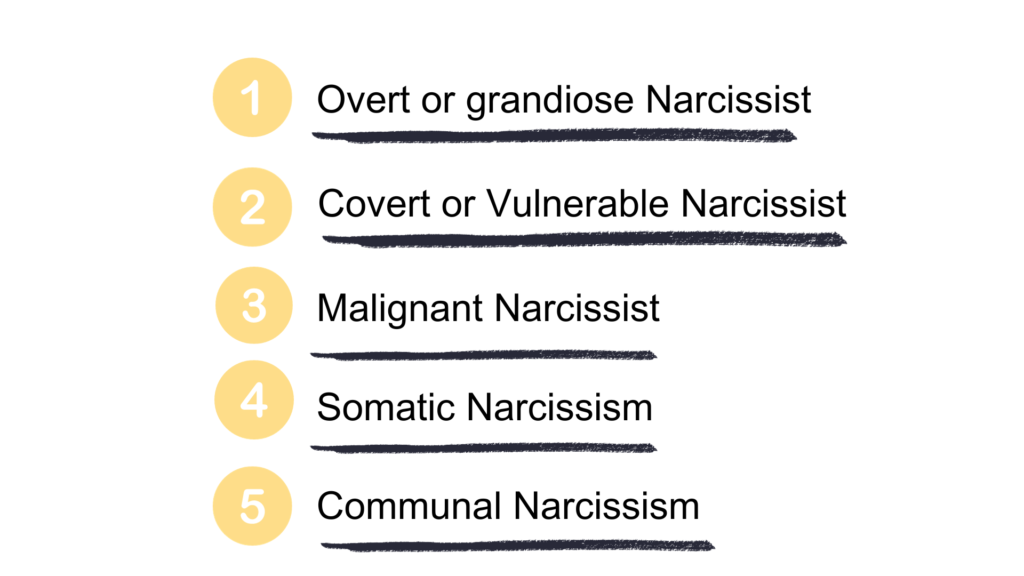The task of exposing and dealing with narcissism is not so easy. We often misunderstand this psychological phenomenon; it’s far more complex than inflated self-esteem.
Narcissism cannot be diagnosed or detected by physical blood tests, MRI or other diagnostic procedure. Even therapists make assessments based on the behaviors and attitudes of individuals.
This blog will delve deep into the psyche of narcissists by exploring their five main narcissistic behaviors.
Table of Contents
What is a Narcissist?
A narcissist is an individual characterized by an excessive interest in oneself and a lack of empathy towards others.
The habit of a narcissist often revolves around self-admiration, seeking admiration from others, and a sense of entitlement.
In short, a narcissist is a person who believes that he is better than anyone else.
5 Types of Narcissists
Before labeling someone as a narcissist, let’s have a look at 5 types of narcissists.

1. Overt or Grandiose Narcissist
This type of narcissist tends to be extroverted. In addition to being extroverted, overt narcissists are frequently selfish and uncooperative. They can be bold and confident because of their inflated sense of self. They also exaggerate their emotional intelligence.
2. Covert or Vulnerable Narcissist
Covert narcissists are introverted. Unlike grandiose narcissists, these individuals are typically shy and modest. They often have low self-esteem and are pretty sensitive to criticism. Compared to overt narcissists, they are less prone to exaggerate their emotional intelligence, but they can still be defensive.
3. Malignant Narcissist
Just as their name suggests, malignant narcissists are cunning and manipulators. Sadism and aggressiveness are seen in them. Their behavior tends to be antisocial. They get pleasure when they see people in pain and discomfort.
4. Somatic Narcissism
This type of narcissist feels more beautiful, stronger, or fitter than others and seeks attention and admiration. Physical appearance and weight are significant sources of obsession for somatic narcissists, who also tend to judge others based only on appearance. They usually prioritize their own need and ignore others.
5. Communal Narcissistic Behavior
Those who exhibit communal narcissistic behaviors typically present a humanitarian image and express a great concern for justice. These narcissists give an impression of selflessness and assistance to others, but their actions are driven by a sense of superiority and a desire for social power.
What are the 5 Main Habits of a Narcissist?
People who have narcissistic personality disorder (NPD) frequently exhibit certain narcissistic behaviors, which might include manipulation and exploitation as well as attention-seeking behavior.
Let’s take a look at the five main habits of narcissists.

1. Grandiose Sense of Self-importance
A sense of grandiosity is one of the defining habits of narcissists. They have an exaggerated sense of self-importance. Narcissists believe that they are unique or superior to others around them and can be understood by other special people.
They, therefore, expect special treatment in all contexts—personal, professional, and social. Their belief in their superiority often overshadows the feelings and needs of others.
This habit manifests in their excessive need for admiration, sense of entitlement, and tendency to exaggerate their achievements.
This habit can limit your personal growth and development, so learn to break the habit of being yourself.
I. Extreme Obsession with Their Physical Appearance
It is one of the ways narcissists express their grandiose sense of self-importance. They spend much time, energy, and resources establishing an idealized self-image, believing their physical appearance reflects their inherent superiority.
II. The Illusion of Success and Superiority
They exaggerate their achievements, skills, and experience to create an illusion of success and superiority, aim to impress others, and gain admiration. They are preoccupied with fantasies of unlimited success and achievements.
2. Lack of Empathy
The ability to see things from another person’s perspective and understand the feelings and emotions of others is known as empathy. A lack of empathy is also one of the main habits of narcissists.
It can be divided into two types;
- Cognitive empathy describes understanding other people’s emotions and perspectives without feeling them.
- Affective empathy involves feeling and sharing other people’s emotions.
Narcissists possess cognitive empathy but lack affective empathy, which is the emotional bond required to have genuine compassion for others.
Lacking empathy is one of the main habits of narcissists. They struggle to understand or relate to others’ emotions, often dismissing feelings that do not align with theirs. Their lack of affective empathy adds to their self-importance and disinterest in other people’s feelings and needs.
This habit leads to shallow relationships and a disregard for the impact of their actions on others. To build healthy relationship habits, it’s crucial to avoid marrying a girl with this weird habit of narcissistic traits.
3. Praise, Praise, and More Praise
Narcissists need undeserved praise and special treatment from others regularly. The inflated sense of superiority surrounding narcissism is like a balloon that gradually loses air without consistent praise and appreciation.
Their reliance on external praise is deeply rooted in fragile self-esteem. They use this praise to sustain their exaggerated sense of self-importance and superiority. It’s not just about feeling good temporarily; it’s about feeding an internal thrust and emptiness that can never be filled.
Attention-seeking is the main habit of a narcissist. The constant need for praise often leads narcissists to engage in attention-seeking behaviors.
- Narcissists will do anything to gain the attention of others for praise and admiration. They sometimes take significant steps, such as
- They dressed provocatively, making large gestures or inflating stories to get the desired attention.
- In social contexts, they could also try to attract attention by being loud and aggressive or dominating behavior.
4. Lake of Accountability
Persistent inability to accept responsibility for their actions is one of the prominent characteristics of a narcissist. Narcissist people with this habit do the following.
I. Blaming others
It is an essential tool of a narcissistic manipulative box. Instead of accepting their mistakes and errors, they blame others or make excuses to maintain their inflated self-esteem.
II. Excuse-Making
When confronted with their mistakes, narcissists often make excuses rather than owning up to their behavior. They might rationalize their actions, making it seem as though their choices were justified or unavoidable.
For instance, a narcissistic partner might justify their infidelity by blaming their spouse for not meeting their emotional needs, rather than acknowledging their own betrayal.
III. Projection
Projection is a defense mechanism commonly used by narcissists, where they attribute their own negative traits or behaviors to others. By projecting, they avoid facing their own flaws and continue to see themselves in a positive light.
Taking responsibility for their faults would force them to face their shortcomings and weaknesses, which is incompatible with their selfish nature. They will go to great lengths, including the habit of lying and manipulation, to maintain the illusion of perfection.
5. Exploiting others for their Benefits
The habit of exploiting others is one of the significant narcissistic traits. Narcissists often view people around them as tools to serve their needs and ambitions.
Exploitation in the context of narcissism involves using others for personal gain without genuine regard for their well-being or autonomy. It manifests in various forms, including:
I. Manipulation and Control
Narcissists are skilled at manipulating situations and people to fulfill their agendas. They may use tactics like gaslighting, guilt-tripping, or emotional manipulation to control others and get what they want.
II. Emotional Exploitation
They exploit others’ emotions for their benefit, disregarding the impact of their actions on others’ mental or emotional states.
III. Using Relationships for Personal Gain
Narcissists might enter into personal or professional relationships solely for what they can gain. They exploit the connection for status, resources, or validation without genuinely investing in the relationship’s mutual growth or well-being.
This habit of exploitation stems from a deep sense of entitlement and a lack of empathy.
These are the 5 main habits of narcissists, but not all of these narcissistic behaviors are required to determine narcissism. The Diagnostic and Statistical Manual states that a person must demonstrate only 55% of the specified narcissistic traits to be diagnosed with narcissistic personality disorder.
Considering the complexity of these narcissistic behaviors, you might wonder how many days it takes to break a habit, especially one as deeply ingrained as narcissism. Understanding the timeline and effort needed to alter these habits can be crucial for those striving for change.
What are the signs and symptoms of narcissism?
Recognizing people with narcissistic personality disorder (NPD) involves observing a series of signs and symptoms that are characteristic of this personality type. These signs may include
- An excessive need for praise
- A disregard for accountability
- Manipulative behavior
- They are exploiting others to fulfill their desires.
Conclusion
In conclusion, understanding the 5 main habits of Narcissists enables us to navigate relationships and interactions more effectively. Identifying narcissistic traits, recognizing various types, and discerning their habitual behaviors assist in reducing the negative consequences of interacting with such individuals.
Understanding and recognizing these five habits helps us better understand narcissism and also acts as a preventative measure. Remember, it is essential to obtain professional advice and assistance when dealing with or encountering narcissistic behaviors in oneself or others.
FAQs
Can narcissistic behaviors be treated or changed?
Yes, narcissistic behaviors can be treated and changed, but the extent to which they can be modified depends on various factors, including the individual’s desire to engage in therapy and the intensity of their narcissistic tendencies, narcissistic traits, and the presence of underlying psychological issues. While complete eradication of narcissistic behaviors may be challenging, therapy can help individuals develop insight into their behavior, cultivate empathy, and learn healthier ways of relating to themselves and others.
Are all habits of narcissists always apparent?
The manifestation of narcissistic behaviors can vary greatly depending on the individual and the context. While some habits of narcissists may be overt and readily observable, others may be more subtle or concealed, making them less apparent to those around them.
Additionally, different types of narcissists may exhibit their traits in distinct ways. For example, grandiose narcissists may openly display their sense of superiority and entitlement, while vulnerable narcissists may mask their insecurities with self-deprecating humor or passive-aggressive behavior. Therefore, while certain habits of narcissists may be noticeable, others may require closer observation and understanding of individual dynamics.




